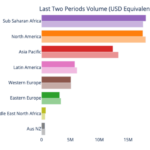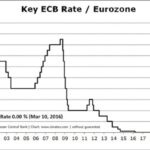Through the “yield and volatility ratio,” traders can find major bitcoin price upside and ways to manage downside risk.
A major thing that anyone who follows Bitcoin notices is how market sentiment can shift seemingly in moments. We’re one Elon Musk tweet away from a bear market, one Tesla earnings report away from a huge bull market. It is about as emotional of a market as you will ever find. The question is: What are metrics that we can use to quantify where we are on this emotional spectrum?
One thing that I like to keep an eye on is the ratio of how the calls and puts are trading in a specific month, let’s call it the “yield and volatility ratio.” Basically, it considers the distance like-priced calls and puts are from the current price of spot bitcoin and divides the difference in price between the calls and the spot bitcoin price by the price between the puts and the spot bitcoin price. How high or low this metric goes is determined by many things, but primarily by the implied volatility of the options skew and the futures yield curve — giving the metric its name. This ratio can give a very good idea of how the market is currently forecasting the price of bitcoin. What’s the sentiment? Is bitcoin about to moon? Or is the run over, and we should prepare for a three-year bear run?
It’s best to illustrate this by using some examples from the past few months. On May 11, 2021, with the bitcoin spot price at $55,000, let’s look at what the ratio was for the September 24, 2021, expiration on Deribit:
The $50,000 put was trading at the same price as the $80,000 call. This means that the put strike was $5,000 away from the spot bitcoin price, while the call strike was $25,000 away from the spot bitcoin price. Dividing the difference in the call strike from spot bitcoin ($25,000), by the difference in the put strike ($5,000), we see that the ratio is at 5:1.
Five to one is a very high score on this metric. As you might recall at the time, bitcoin was in full-on bull-market mode. One trade idea you could use to take advantage of these market conditions would be to do the following:
+Bitcoin at $55,000
+50,000 put
-80,000 call
Zero cost
By trading with this strategy, you would have the following exposure to bitcoin until options expiration:
On the downside, you are long at $55,000, but can only lose money until the $50,000 put strike, where your losses are stopped out, meaning you can lose up to $5,000. To the upside, you will profit until you reach the $80,000 price level, where you are capped at $25,000 profit. This means you can realize $25,000 profit (45% higher), while only risking $5,000 (9%) of potential losses. Notice again, that 5:1 ratio.
I like these odds. Given that I am long-term bullish overall on bitcoin, it can be tough to find suitable ways to hedge your long-term exposure, as I generally don’t like selling spot bitcoin. However, when we see the call/put ratio get to levels as high as 5:1, I like hedging a percentage of my overall exposure by selling calls and buying puts.
Contrast that with just over a month later, on June 21, 2021, you could interpolate the ratio for the July 30, 2021, expiry using the following inputs: with the bitcoin spot price at $36,000, the $32,000 puts would match the price of the $41,000 calls. This puts the ratio at 1.25:1.
What would be a trade idea in this market? I like doing the opposite of the recommendation above. This time, it pays to just buy the calls and sell the puts. Think about it, just in pure mathematical terms, the most you can lose on the puts is $32,000 — assuming BTC goes all the way to $0. But the upside is unlimited. Given bitcoin and its ability to go parabolic, it doesn’t make sense for this ratio to approach 1:1.
What does the ratio look like currently? As we have seen yields increase recently on the latest rally, the ratio has increased, particularly as you go further out in time. As of August 24, the ratio for the December 31 expiry is at 2.80:1. (Note: this is an approximation as it can vary depending on which initial call or put strike you choose. For consistency, I like to select a put approximately 10% lower than spot, and then to solve for the call.) It has certainly bounced off its recent lows, but likely still has more potential to expand in the coming months, especially when higher yields begin to return to the futures market. It’s not the worst idea to sell some of the ratio via selling calls or buying puts. But I would do so sparingly, as chances are we will continue to see the ratio grow to higher levels.
Most importantly, although the metric gauges where we are on the emotional spectrum at any certain time, make sure to control your own emotions. It’s important to keep a level head through it all and play the hand the market has dealt you.
This is a guest post by Patrick Baker. Opinions expressed are entirely their own and do not necessarily reflect those of BTC Inc or Bitcoin Magazine.





 BTC-USD
BTC-USD  ETH-USD
ETH-USD  LTC-USD
LTC-USD  XRP-USD
XRP-USD